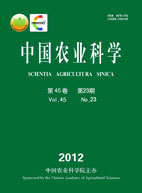-
Root Morphological and Activity Characteristics of Rice Genotype with High Nitrogen Utilization Efficiency
- JI Lin, LI Ting-Xuan, ZHANG Xi-Zhou, YU Hai-Ying
-
Scientia Agricultura Sinica. 2012, 45(23):
4770-4781.
doi:10.3864/j.issn.0578-1752.2012.23.003
-
 Abstract
(
964 )
Abstract
(
964 )
 PDF (592KB)
(
1550
)
PDF (592KB)
(
1550
)
 Save
Save
-
References |
Related Articles |
Metrics
【Objective】 The substantial reduction in fertilizer inputs and the selection of genotypes with high nutrient utilization efficiency or aggressive nutrient acquisition are beneficial to soil fertility in crop production by low-input approach. In order to provide a theoretical basis for cultivation regulation and breeding improvement of roots, roots morphological and activity characteristics of rice genotype (Oryza sativa) with different nitrogen utilization efficiencies (NUE) were investigated under different nitrogen treatments. 【Method】 Three pot culture experiments were carried out in a net room on the farm of Sichuan Agricultural University, Sichuan province, China in 2008 and 2009, including soil culture experiment with nitrogen treatments of 200 mg?kg-1, hydroponics of root morphological experiment with nitrogen treatments of 20 mg?L-1, 40 mg?L-1, and hydroponics of root physiological experiment with nitrogen treatments of 10 mg?L-1, 20 mg?L-1, 40 mg?L-1, 60 mg?L-1. In this research, root morphological characteristics of fine lateral root, coarse lateral root, and adventitious root were analyzed by root analysis system of WinRHIZO. The relationship between the root characteristics and nitrogen accumulation was also analyzed. 【Result】Rice grain yield and nitrogen utilization efficiency showed extremely significant genotype differences. Grain yield, nitrogen accumulation of grain, nitrogen dry matter production efficiency, nitrogen utilization efficiency and nitrogen harvest index of high NUE were 50.20%, 34.20%, 11.48%, 26.01% and 12.50% higher than those of low NUE. Dry matter weight, nitrogen accumulation and grain yield, nitrogen utilization of rice showed a significant or very significant positive correlation at jointing stage and heading stage. Under the low nitrogen treatment, a significant difference in root morphological characteristics of different types between high NUE and low NUE. Fine lateral root length of high NUE was 32.09%, 14.66%, 14.40% and 12.69% higher than low NUE at seeding, tillering, jointing and heading stages, respectively. Coarse lateral root surface area of high NUE was 94.70% and 64.38% higher than low NUE at jointing and heading stages, while root volume was 90.24% and 58.18% higher. Adventitious root length, surface area and volume of high NUE were 40.84%, 44.90% and 51.02% higher than those of low NUE at jointing stage. Root total absorbing surface area, active absorbing surface area and reducing capacity of high NUE decreased significantly with the increase of nitrogen at different growing stages. Under the same nitrogen treatment, root total absorbing surface area, active absorbing surface area, oxidation ability and reducing capacity of high NUE were 1.3-2.1 times, 1.1-3.2 times, 1.0-3.0 times and 1.4-2.2 times higher than those of low NUE. Under the low nitrogen treatment, length, surface area and volume of coarse lateral root had the greatest influence on nitrogen accumulation, the influence degree was 47.1-78.4%. 【Conclusion】 Good root morphology and physiological activity are the important characteristics of high NUE under the low nitrogen treatment. Rice genotype with high nitrogen utilization efficiency can be cultivated through improving the quality and quantity of coarse lateral root in order to obtain good root configuration.









